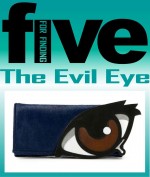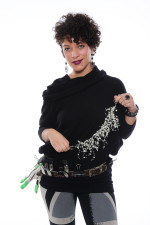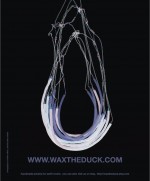We are, every one of us, mothers to an unruly family: the members of a collectively-mismatched but individually-cherished brood of children who comprise our jewelry box. Feather earrings–the free-spirited daughter, barefoot, running through a hydrant on a summer day. A pearl choker–studious, future-minded, voted “Most Likely to Succeed.” Each her own person, they’re both reflections of influences past as well as projections of our ability to nurture through to maturity pride and self-confidence.
Invariably, there’s a free spirit, swapping almost immediately one passion for the next. This week, she wants to visit Peru; the next, she’s all about mixing beats with a local artist. Then, researching her family’s roots in the South or running to Vegas to try her luck as a dancer. This character–she’s your charm bracelet.
I’m not much of a fan. Charms have long struck me as cover material for The Idiot’s Guide to Personal Style because their components are by nature, literal: “I like travel,” a plane; “I like winter,” a snowflake; “I like love,” a heart. Nothing to interpret, nothing to discuss. Like a bad first date, things are pretty much obvious on sight.
I was working my first of two stints at a brand where a co-worker was trying to rally support for a design based on her favorite charm: the evil eye. A gold, open-faced hand with lines etched below the fingers to denote eyelids, the iris and pupil, it seemed entirely too creepy to adapt for widespread popularity. Of course, she was an accountant and not on the creative team, so make of her passion what you will.
Cultural use of the evil eye dates from the thousands of years–examples of its display discovered across a swath of different civilizations and religions–as a ward against spirits believed to cast curses with a simple glare. The meaning has evolved over millennia, and many now associate it primarily with good luck despite retaining that sinister element the original purposefully conveyed.
Design based on societally off-putting symbols garners critical praise coupled with abysmal sell-through. Eight or so years ago, I came across a brilliant J.Crew wristlet with a pattern based on nineteenth century drawings of beetles, something I’ve seen echoed only twice since (five years ago at Paul Smith and last year at Lanvin). Contrasted with regular market appearances of butterflies, perhaps it makes sense that you’re more likely to find one bug than the other as a silver charm.
This doesn’t keep designers from experimenting with emblems like the evil eye, but from a financial perspective, brand directors need to mitigate the sales risk. Prints might be softened, production quantities lowered. So the fact that several companies have used the motif recently strikes me as at least notable if not an all out “trend.”
Perhaps you appreciate a beauty in the grotesque. Perhaps you’re comfort in the idea of luck is strong enough to merit expression in what you wear. Or maybe you’re that daughter of ours–a free spirit for whom the evil eye is the best-thing-ever. This week. Until the next best-thing-ever. But to be sure, you won’t lack choice just now.
These are five evil eye bags for finding:
1. Billabong, $39.50
2. Falconwright, $78
3. Pierre Hardy, $795
4. MCM, $895
5. Ines Figaredo, $2284





